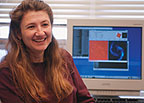Research Notes
Planet Discovered
Using a new technique that examines patterns of interstellar dust, Alice Quillen,
assistant professor of physics and astronomy, has discovered
a previously unknown planet orbiting the star Epsilon Eridani, about 10 light
years from Earth. The planet, Epsilon Eridani C, has a mass one tenth
that of Jupiter and a 280-year orbit—the longest, largest orbit of any
known planet. Quillen’s technique and the results, published in The
Astrophysical Journal Letters, offer a new tool for astronomers to detect
relatively small planets or those in orbits far from a parent star. Conventional
detection methods watch for planets large enough or close enough to exert
a noticeable gravitational pull on their parent star.
RNA Discovery Named ‘Breakthrough of the Year’
The journal Science has named small-RNA research done by Martin Gorovsky, Rush Rhees Professor of Biology, as the most important scientific breakthrough of 2002. Gorovsky and three other scientists were heralded for their work in understanding how pieces of RNA can control genetic development. The team’s work has revealed how a single-celled organism transfers its genetic code from one of its nuclei to one of its offspring.
Study Examines Huntington’s Early Symptoms
When does Huntington’s disease start? Medical Center neurologist Ira Shoulson has launched a nationwide study to gain greater understanding of the disease’s earliest symptoms. Funded by a $5.2 million grant from the National Institutes of Health, researchers are closely observing the health of people who have a parent with the disease, caused by an inherited defective gene that leads to the destruction of brain cells. The study is focusing on people who have not had the genetic test that predicts whether they will develop the disease.
Compound Helps Brain Cells Survive After Stroke
A compound already used to treat severe sepsis could open a new approach for treating stroke, the leading cause of long-term disability in the nation, thanks to a study led by Medical Center neuroscientist Berislav Zlokovic. In the study, published in Nature Medicine, researchers found that the intervention of a compound known as activated protein C helps curb the automatic response of damaged cells to die off. In the study, which examined mice that had strokes, the compound reduced the neurological impact of a stroke by 91 percent.
New Technique Focuses on Photo Manipulation
People who use digital images may soon have a way of ensuring that the images they’re viewing have not been altered. Murat Tekalp, professor of electrical and computer engineering, and student Mehmet Celik—along with colleagues at Xerox—have developed a new technique to watermark images. Called “reversible data hiding,” the new process allows images to be enlarged or enhanced to show detail without distorting the original.
![[NEWS AND FACTS BANNER]](/URClipArt/news/titleNewsFactswide.jpg)

